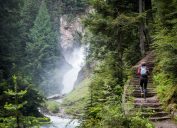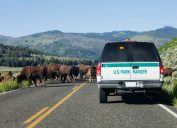14 Underrated U.S. National Monuments That Should Be on Your Bucket List
These beautiful American monuments make the perfect vacation destinations.
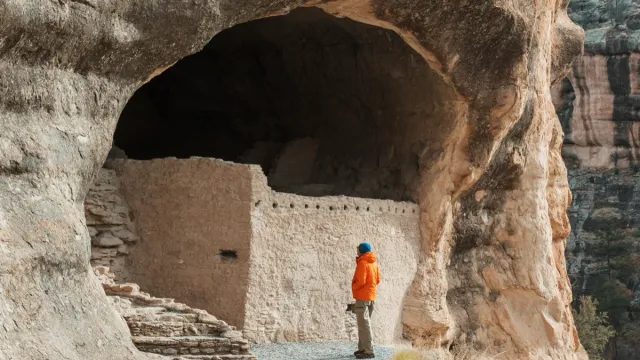
Off the top of your head, you can probably name a few of the most famous U.S. national monuments. Perhaps the iconic Statue of Liberty in New York is the first to come to mind, but that's just one of approximately 133 national monuments across the nation. According to the National Park Service (NPS), the designation is given to a range of different sites, including "natural reservations, historic military fortifications, prehistoric ruins, and fossil sites." Of these many national monuments, however, there are some that travel experts say are truly underrated.
These areas tend to be smaller than national parks, and as such, they generally don't have as many attractions. But that doesn't mean they aren't well worth visiting, as they allow you to explore different parts of the U.S. outside of their more well-known (and sometimes more crowded) national park counterparts. In fact, travel experts say some monuments are so exceptional, they deserve a spot on the top of your list. Read on to find out which nine sites they recommend.
RELATED: 8 Best National Parks to Visit on a 3-Day Weekend.
1
Chiricahua National Monument (Arizona)

Head out west to explore Chiricahua National Monument in Arizona, described by the NPS as the "Wonderland of Rocks."
"Chiricahua is a hidden gem in Southern Arizona that remains unknown to most, including many locals!" Adam Marland, travel photographer and writer for We Dream of Travel, tells Best Life.
As Marland explains, the site was formed after an eruption of Turkey Creek Volcano, which sprayed ash across 1,200 miles. Over thousands of years, this settled and formed the "geological marvel," he says.
"In Chiricahua, the NPS protects a world of strange rock formations in the least expected location," Marland adds. "A hike through Echo Canyon reveals an impossible display of balanced rocks, columns, and pinnacles."
The site was even nominated as an International Dark Sky Park in 2021 and is an ideal spot "to view our celestial world," according to Marland. The Dark Sky designation is given to sites "possessing an exceptional or distinguished quality of starry nights," as well as a "nocturnal environment" protected for education, science, cultural heritage, and public enjoyment, the International Dark-Sky Association states.
2
Muir Woods National Monument (California)
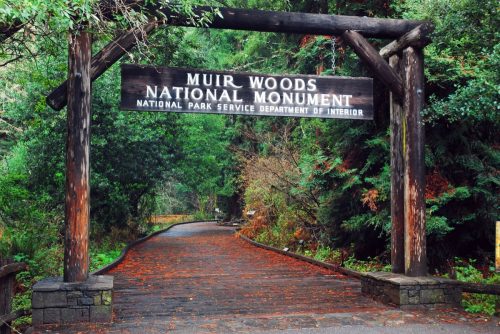
Another site that you may not be familiar with—or recognize as a national monument as opposed to a national park—is Muir Woods National Monument in California. The forest of towering redwoods has been a national monument since 1908, but it's still drawing visitors who seek adventure off the beaten path.
Parking reservations are required, but according to an April 2023 TikTok video from travel TikTok account @where.we.wandered, it's worth it to plan ahead for the sights at this spot.
"Muir Woods is a mystical redwoods forest less than an hour away from San Francisco," the video caption reads, pointing to both accessible and challenging trails. "While you are walking through the forest, you will be amazed by the gigantic redwood trees, the fresh air, and the sound of the water running down the creak."
The park is open year-round, but peak season is between May and October, so prepare for crowds if your visit is during that time, @where.we.wandered advises.
"Enjoy getting lost amongst the trees," the caption continues. "Muir Woods is truly an escape into nature. We spent about 2 hours walking through the park and admiring its beauty."
RELATED: 10 Best National Parks You Can Walk Through.
3
Colorado National Monument (Colorado)
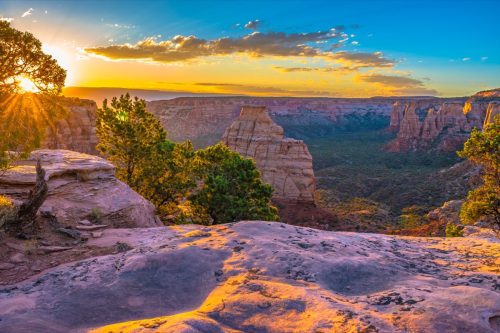
Another underrated monument to make the list is in the Centennial State. Sophie Clapton, travel blogger for We Dream of Travel, asserts that Colorado National Monument is "often overlooked," despite its massive monoliths and red rock canyons.
"It's primarily used as a scenic detour wherein passerby can enjoy the elevated 23-mile drive over the 'pocket-sized Grand Canyon,'" she says.
The park was first promoted by trail builder John Otto in 1906, and thanks to his efforts, then-President William Howard Taft signed the proclamation to establish the monument in 1911. Legend has it that Otto looked up from the base of the canyon and "wondered what it would be like to view the world as the birds did," Clapton tells Best Life.
The historic site is a great destination for nature lovers, as well as those who want to catch a glimpse of native flora and fauna.
"Along this photogenic route, visitors can expect to encounter a colorful array of rock islands, spires, pinnacles, and sheer canyon walls," Clapton shares. "With a little luck, there's a good chance the scenery will be shared with a wide variety of wildlife, including bighorn sheep, golden eagles, and mule deer."
4
Gila Cliff Dwellings National Monument (New Mexico)

Next up on the list of underrated national monuments is Gila Cliff Dwellings in New Mexico. In the 1200s, the Mogollon people established their homes in natural caves, building rooms and raising children for one to two generations, according to the NPS. The dwellings were abandoned after the Mogollon people departed in the 1300s, but today, the 42 rooms they constructed from local stone still exist—and you can see them for yourself.
According to full-time traveler and TikToker @mindyonthemove, this spot is not to be missed, nor is the surrounding Gila National Forest.
"Not only are these cliff dwellings absolutely fascinating, but the Gila National Forest itself is overflowing with wilderness beauty, hot springs, and so much more," @mindyonthemove says in a June 2023 TikTok.
Highlights for her included Gila's Cliff Dwellings trail, Gila's Trail to the Past, Gila Hot Springs, Mineral Creek Trail, Melanie Hot Springs, and Middlefork Hot Springs Trail.
5
John Day Fossil Beds National Monument (Oregon)

If you've wondered what the U.S. was like in the prehistoric era, you'll find answers at John Day Fossil Beds National Monument in Oregon.
"This area offers one of the world's most continuous collections of fossils and other geological features from the Tertiary Period, which spanned between 5 and 50 million years ago," Jessica Schmit, of the travel site Uprooted Traveler, tells Best Life.
Schmit explains that the monument is divided into three main units, but Painted Hills is the most famous of the trio.
"Here, you can explore five hiking trails that weave around and between enormous striated hills, painted with vibrant shades of green, red, and orange," she says. "These colors are remnants of significant and sudden climate change in the area some 30 million years ago."
According to the NPS, the three units at John Day Fossil Beds are between one and two hours apart, but you can also take in the scenery on the drive. If you're hoping to hike, the drive to Clamo or Sheep Rock will be worth it, as both offer a great opportunity to explore our prehistoric past.
Clamo and Sheep Rock both "have an impressive collection of fossils, many of which have helped scientists piece together the evolution of dogs, cats, and other mammals," Schmit says.
RELATED: The 10 Most Naturally Beautiful States in the U.S., Data Shows.
6
Canyon de Chelly National Monument (Arizona)
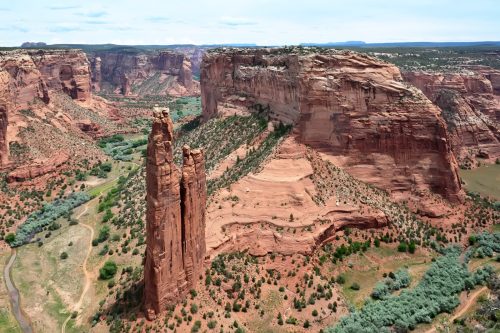
Canyon de Chelly National Monument also warrants a top spot on your bucket list, Steve Morrow, travel expert and founder of Paddle About, says.
"Located in northeastern Arizona, this canyon is home to some of the most breathtaking scenery in the country," he shares. "Formed over millions of years by the erosion of soft limestone layers, the canyon is a wonderland of towering cliffs, winding canyons, and colorful rocks."
The entire national monument is situated on Navajo tribal lands, and families still reside on the canyon floor, per the park's website. During your visit, you can take in the views from two rim drives and nine overlooks (including the famed Spider Rock overlook) and explore the canyon walls the house pueblo ruins constructed between 350 and 1300 A.D.
"Although it's not as well-known as some other national parks in Arizona (like Grand Canyon National Park), Canyon de Chelly is definitely worth visiting," Morrow says. "So if you're looking for an unforgettable nature experience, check [it] out."
7
Organ Pipe Cactus National Monument (Arizona)
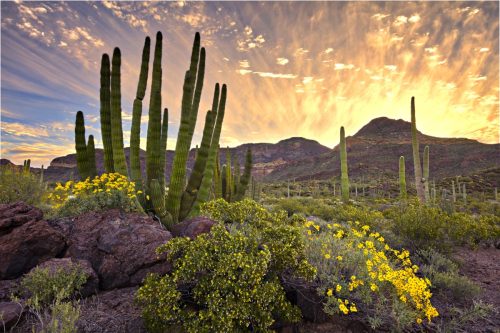
If your ideal excursion involves natural flora, you must check out Organ Pipe Cactus National Monument in Arizona. This is actually the only place in the U.S. where you can see organ pipe cacti growing naturally!
It's often cited as an underrated spot, with travel bloggers @thenationalparktravelers pointing to the monument as "a place in Arizona no one is talking about."
According to @mindyonthemove, the hiking is just as amazing as the plants and vegetation. If you get a chance to visit, check out Arch Canyon Trail (especially if you can go after sunset), Alamo Canyon, Victoria Mine, and Lost Cabin Trail, per her recommendations.
8
Grand Staircase-Escalante National Monument (Utah)
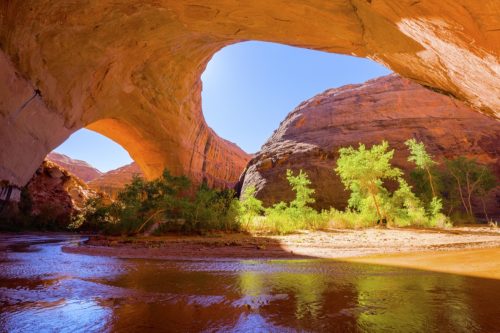
Another national monument that should claim a spot on your bucket list is Grand Staircase-Escalante National Monument in Utah. According to Avichai Ben Tzur, publisher of the in-depth travel guide website X Days In Y, those who enjoy desert scenery and taking road trips will be particularly enthralled by Grand Staircase.
"This Southern-Utah national monument is wedged between Bryce Canyon and Capitol Reef National Parks, extending over 1.8 million acres of sandstone canyons, plateaus, cliffs, and unique rock formations," he says. "The immense national monument is perfect for a one-day visit for travelers heading to Moab from Bryce Canyon, or on an extended stay that allows discovering some of the monument's gems."
Ben Tzur recommends visiting in the early fall or late spring when temperatures are a bit cooler and you can enjoy stopping at Head of the Rocks Overlook or hiking to "the desert oasis of Lower Calf Creek Falls." Looking to take a drive? He also suggests heading to Hells Backbone.
"Because of its size and lack of extensive tourist infrastructure, Grand Staircase receives just a fraction of the visitor numbers that flock to its neighboring national parks," Ben Tzur notes. "However, those who seek to get off the beaten track and experience Southern Utah without the crowds will cherish their visit."
RELATED: The 10 Best Mountain Towns in the U.S.
9
Lava Beds National Monument (California)

Next up on the list of underrated spots is Lava Beds National Monument. Described as a "land of turmoil, both geological and historical" by the NPS, this spot was formed by volcanic eruptions and is also rich in Native American history thanks to its rock art sites, battlefields, and campsites.
@mindyonthemove points out that exploring here is self-guided, which makes a trip that much more fun.
"Here, you can explore SO many lava caves at your own risk! No guide! Which, to me, is so dang awesome," she says in the June 2023 video. "But be sure to stop at the visitor's center to obtain a caving permit, and be sure to bring a headlamp and/or flashlight."
Skull Cave is on @mindyonthemove's list of favorites. According to the NPS, the cave is a "remnant of three very large lava tubes," and as a bonus, it's wide open, making it a great spot for explorers who don't like tight spaces.
Symbol Bridge Cave and Big Painted Cave, both of which showcase Native American pictographs, were other favorites.
10
Florissant Fossil Beds National Monument (Colorado)
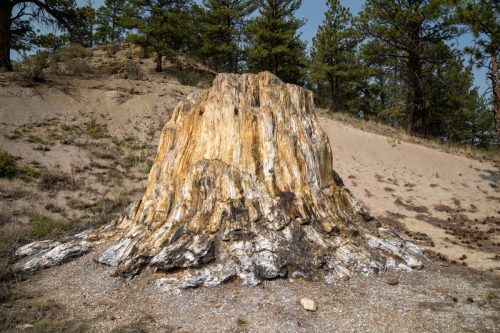
Another haven for fossil-lovers is Florissant Fossil Beds National Monument in Colorado. Enormous petrified redwood stumps are scattered throughout the site, containing insect and plant fossils from prehistoric times.
"I'd go so far as to call this one more impressive than Petrified Forest National Park in Arizona," Agnes Groonwald, travel writer and founder of Travel on the Reg, says. "While this one isn't as large, the tree stumps themselves are bigger than what you'll find in the desert."
Groonwald flags the indoor and outdoor exhibits at the monument's visitor center as must-see spots, as well as the "Big Stump," which measures 12 feet in diameter. According to the NPS, the tree may have been over 230 feet tall before its base was buried by volcanic mudflow somewhere between 500 and 1,000 years ago.
With so much to see, you'll likely be ready to plan your trip sooner rather than later—and luckily, the park is a "year-round destination," Groonwald says. However, you'll need to be mindful of the weather.
"You're at 8,500 feet above sea level while you're there, so winter temperatures require lots of warm layers," she explains, noting that she visited the park when temperatures were warm and sunny in July. If you're hiking at this time, she suggests "more water than you think you'll need," as most of the trails aren't shaded.
11
Devils Tower National Monument (Wyoming)
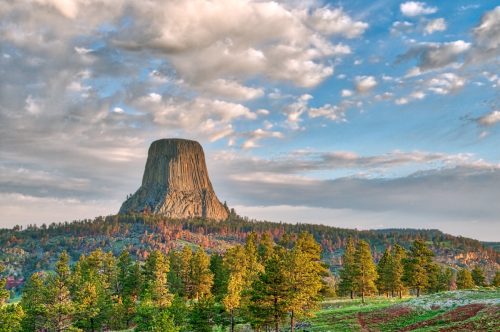
While it's arguably one of the more recognizable national monuments, Devils Tower is a necessary addition to any traveler's bucket list. Jutting up from the prairie around the Black Hills of Wyoming, the "tower" was a sacred spot for Northern Plains Indians and indigenous people, per the NPS. Legends vary from tribe to tribe, but there's also a scientific explanation for the formation.
"Science tells us that Devils Tower was formed underground from molten rock and was pushed up by magma into sedimentary rock … 50 million years ago," hiker Gavin Hungerford (@gavinhikes) explains in an Aug. 2021 TikTok.
Hungerford also offers a few recommendations for visiting this "867-foot monolith of granite," including catching a glimpse of wildlife in "Prairie Dog Town" near the entrance of the spot.
"[It's] an awesome spot to watch these communal animals in their wild habitat," Hungerford says. From there, he recommends taking on the Tower Trail hike, which takes you on a 1.3-mile trek around the tower.
"It is paved and accessible to all, giving you great views of the tower, pine forests, and grasslands—I also saw some deer along the way," Hungerford explains. (The NPS notes that the trail isn't Americans with Disabilities Act [ADA] approved after reaching the intersection of the loop past the pavilion at the start of the Tower trailhead.)
Hungerford continues, "Native Americans consider this site sacred, and you may see some prayer cloths along the route."
"As a culturally significant site, some perceive climbing up the tower disrespectful," he points out, noting that roughly 5,000 people do travel to climb the tower annually. "The NPS is trying to respect its spiritual significance by having a voluntary climbing closure every June."
12
El Morro National Monument (New Mexico)
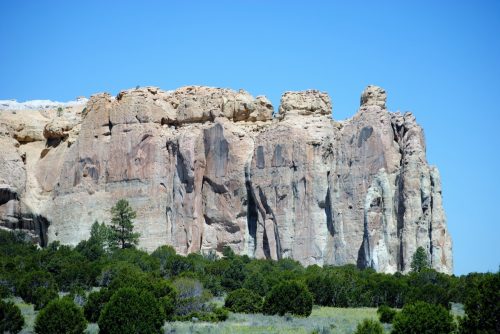
Head to western New Mexico and you will find El Morro National Monument. For hundreds of years, this site offered refuge for travelers thanks to a "reliable waterhole" at the base of the monument's sandstone bluff, according to the NPS. Fred Baker, senior travel editor of Travelness, says this monument is not to be missed, as it's truly a "hidden gem."
El Morro "offers visitors stunning views of natural sandstone formations, as well as a glimpse into the history of the area," he shares. "El Morro was once a popular stopover point for Spanish conquistadors and early American settlers, and today, visitors can still see the petroglyphs and inscriptions left behind by these early travelers."
Much like Grand Staircase-Escalante, Baker recommends planning your visit in the fall or spring, when you'll have cooler weather and fewer crowds. You can take advantage of all the hiking and walking experience, namely the Inscription Trail, Headland Trail, and Atsinna Trail.
"However, regardless of when you visit, El Morro is sure to leave a lasting impression," he gushes.
RELATED: 63 National Park Facts About America's Most Beautiful Destinations.
13
Craters of the Moon National Monument and Preserve (Idaho)
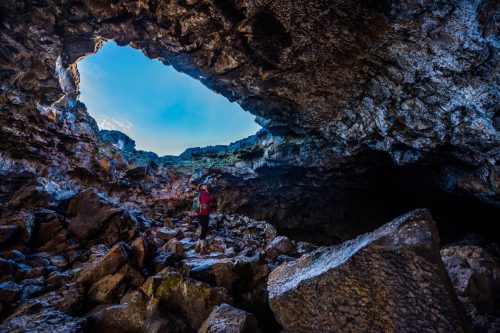
Just as its name suggests, Craters of the Moon National Monument in Idaho is truly otherworldly—even the NPS describes it as "weird and scenic."
"The park contains a variety of different volcano types such as cinder cones as well as splatter cones which are caused later in the eruption cycle," Anwar Y of the travel blog Beyond my Door, explains. "The park is massive, and the majority of the park is actually wilderness. Visitors can even visit 'wild caves,' which are lava tubes that require you to navigate a bit more on your own to travel within."
Wildflowers and other vegetation bloom in the late spring and summer, he adds, and you can see a majority of "the road accessible park" in one or two days. Unlike some of the other national monuments, Craters of the Moon should also be on your list of winter destinations, thanks to all that there is to do.
"In the winter, the park closes the roads and allows cross country skiing, snowshoeing, and hiking," Anwar Y tells Best Life. "Visitors can even hike up volcano cones and ski down if they prefer."
14
Fort Monroe National Monument (Virginia)

If you're planning an adventure on the East Coast, check out Fort Monroe National Monument in Virginia, which was officially designated by President Barack Obama in 2011. A haven for history buffs, the fort is known as "Freedom's Fortress," according to Yuri Milligan, director of media and community relations for the Hampton Convention & Visitor Bureau in Virginia.
"[Fort Monroe] has a diverse history spanning the American story from American Indian presence, Captain John Smith's journeys, arrival of the first enslaved Africans in English North America in 1619, a safe haven for freedom seekers during the American Civil War, and a bastion of defense for the Chesapeake Bay through the 21st Century," Milligan says, adding that it is also the largest stone fort ever built in the U.S.
Even if you aren't into American history, there's more to explore at this site, including a public beach, several places to eat, a Visitor & Education Center, and the Casemate Museum, Milligan adds.
This story has been updated to include additional entries, fact-checking, and copy-editing.
- Source: NPS: What's In a Name? Discover National Park System Designations
- Source: NPS: National Park Getaway: Chiricahua National Monument
- Source: NPS: Muir Woods National Monument
- Source: Colorado National Monument: John Otto
- Source: NPS: Glia Cliff Dwellings: Shedding Light on the Mogollon Culture
- Source: NPS: Top Tips for Visiting John Day Fossil Beds
- Source: NPS: Canyon de Chelly Plan Your Visit
- Source: NPS: Organ Pipe Cactus
- Source: NPS: Lava Beds National Monument California
- Source: NPS: Symbol Bridge Cave
- Source: NPS: Florissant Fossil Beds National Monument: Experience the Fossil History of Colorado
- Source: NPS: Big Stump
- Source: NPS: Devils Tower
- Source: NPS: Devils Tower National Monument First Stores
- Source: NPS: Prairie Dog Town (Devils Tower National Monument)
- Source: NPS: Devils Tower Hiking Trails
- Source: NPS: Craters of the Moon National Monument and Preserve
- Source: The White House Archives: Fort Monroe Becomes a National Monument
